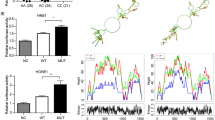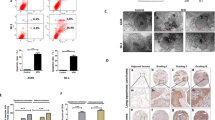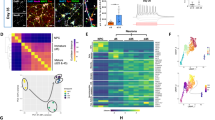Abstract
Pontosubicular neuron necrosis (PSN) represents an age-specific response to severe hypoxic-ischemic injury occurring in human neonates but not in older children or adults. Histologically, PSN is characterized by acute neuronal death in the pontine nuclei and the hippocampal subiculum bearing the hallmarks of apoptosis. In animal models of hypoxic-ischemic injury, induction of neuronal apoptosis can be triggered by Fas (CD95/Apo-1), a cell surface receptor of the tumor necrosis factor-α superfamily, which transduces apoptotic death signals when cross-linked by its natural ligand. Here, we have investigated the expression of Fas/Fas ligand in human autopsy material consisting of 13 PSN cases and 10 age-matched cases without PSN. Terminal deoxynucleotidyl transferase-mediated dUTP nick-end labeling, immunohistochemistry, and double labeling for Fas/Fas ligand and the astrocyte marker glial fibrillary acid protein, the microglia/macrophage specific marker KiM1P, and the neuronal marker NeuN were performed on formalin-fixed brain specimens. Although mainly neurons of both PSN and controls expressed Fas receptor, expression was significantly increased (p = 0.001) in PSN cases in which predominantly degenerating cells with signs of early apoptosis showed Fas expression. In contrast, Fas ligand expression was found mainly on astrocytes and microglial cells. There was no significant difference between cases with and without PSN. We conclude that in the developing human brain, cells expressing the Fas receptor may be susceptible to undergoing apoptosis in response to hypoxic-ischemic injury.
Similar content being viewed by others
Log in or create a free account to read this content
Gain free access to this article, as well as selected content from this journal and more on nature.com
or
Abbreviations
- PSN:
-
pontosubicular necrosis
- HII:
-
hypoxic-ischemic injury
- TUNEL:
-
terminal deoxynucleotidyl transferase-mediated dUTP nick-end labeling
- GFAP:
-
glial fibrillary acid protein
References
Friede RL 1972 Ponto-subicular lesions in perinatal anoxia. Arch Pathol 94: 343–354
Brück Y, Brück W, Kretzschmar HA, Lassmann H 1996 Evidence for neuronal apoptosis in pontosubicular neuron necrosis. Neuropathol Appl Neurobiol 22: 23–29
Wyllie AH, Duvall E 1992 Cell injury and death. In: McGee JO, Isacsson PG, Wright NA (eds) Oxford Textbook of Pathology, Oxford University Press, Oxford, pp 141–193.
Yue X, Mehmet H, Penrice J, Cooper C, Cady E, Wyatt JS, Reynolds EO, Edwards AD, Squier MV 1997 Apoptosis and necrosis in the newborn piglet brain following transient cerebral hypoxia-ischaemia. Neuropathol Appl Neurobiol 23: 16–25
Sidhu RS, Tuor UI, Del Bigio MR 1997 Nuclear condensation and fragmentation following cerebral hypoxia-ischemia occurs more frequently in immature than older rats. Neurosci Lett 223: 129–132
Joashi UC, Greenwood K, Taylor DL, Kozma M, Mazarakis ND, Edwards AD, Mehmet H 1999 Poly(ADP ribose) polymerase cleavage precedes neuronal death in the hippocampus and cerebellum following injury to the developing rat forebrain. Eur J Neurosci 11: 91–100
Edwards AD, Yue X, Cox P, Hope PL, Azzopardi DV, Squier MV, Mehmet H 1997 Apoptosis in the brains of infants suffering intrauterine cerebral injury. Pediatr Res 42: 684–689
Kato H, Kogure K, Liu X-H, Araki T, Itoyama Y 1996 Progressive expression of immunomolecules on activated microglia and invading leucocytes following focal cerebral ischemia in the rat. Brain Res 734: 203–212
Silverstein F, Barks J, Hagan P, Liu X, Ivacko J, Szaflarski J 1997 Cytokines and perinatal brain injury. Neurochem Int 30: 375–383
Lee JM, Grabb MC, Zipfel GJ, Choi DW 2000 Brain tissue responses to ischemia. J Clin Invest 106: 723–731
Nagata S, Golstein P 1995 The Fas death factor. Science 267: 1449–1456
Kischkel FC, Hellbardt S, Behrmann I, Germer M, Pawlita M, Krammer PH, Peter ME 1995 Cytotoxicity-dependent APO-1 (Fas/CD95)-associated proteins form a death-inducing signaling complex (DISC) with the receptor. EMBO J 14: 5579–5588
Aggarwal BB, Singh S, LaPushin R, Totopal K 1995 Fas antigen signals proliferation of normal human diploid fibroblasts and its mechanism is different from tumor necrosis factor receptor. FEBS Lett 364: 5–8
Griffith TS, Brunner T, Fletcher SM, Green DR, Ferguson TA 1995 Fas ligand-induced apoptosis as a mechanism of immune privilege. Science 270: 1189–1192
French LE, Hahne M, Viard I, Radlgruber G, Zanone R, Becker K, Müller C, Tschopp J 1996 Fas and Fas ligand in embryos and adult mice: ligand expression in several immune-privileged tissues and coexpression in adult tissues characterized by apoptotic cell turnover. J Cell Biol 133: 335–343
Streilein JW 1995 Unraveling the immune privilege. Science 270: 1158–1159
Holler N, Zaru R, Micheau O, Thome M, Attinger A, Valitutti S, Bodmer JL, Schneider P, Seed B, Tschopp J 2000 Fas triggers an alternative, caspase-8–independent cell death pathway using the kinase RIP as effector molecule. Nat Immunol 1: 489–495
Cheema ZF, Wade SB, Sata M, Walsh K, Sohrabji F, Miranda RC 1999 Fas/Apo [apoptosis]-1 and associated proteins in the differentiating cerebral cortex: induction of caspase-dependent cell death and activation of NF-kappaB. J Neurosci 19: 1754–1770
Nilsen J, Mor G, Naftolin F 2000 Estrogen-regulated developmental neuronal apoptosis is determined by estrogen receptor subtype and the Fas/Fas ligand system. J Neurobiol 43: 64–78
Nishimura T, Akiyama H, Yonehara S, Kondo H, Ikeda K, Kato H, Iseki E, Kosaka K 1995 Fas antigen expression in brains of patients with Alzheimer-type dementia. Brain Res 695: 137–145
Dowling P, Shang G, Sumul R, Menonna J, Cook S, Husar W 1996 Involvement of the CD95 (APO-1/Fas) receptor/ligand system in the multiple sclerosis brain. J Exp Med 184: 1513–1518
Martin-Villalba A, Herr I, Jeremias I, Hahne M, Brandt R, Vogel J, Schenkel J, Herdegen T, Debatin KM 1999 CD95 ligand (Fas-L/APO-1L) and tumor necrosis factor-related apoptosis-inducing ligand mediate ischemia-induced apoptosis in neurons. J Neurosci 19: 3809–3817
Felderhoff-Mueser U, Taylor DL, Greenwood K, Kozma M, Stibenz D, Joashi UC, Edwards AD, Mehmet H 2000 Fas/CD95/APO-1 can function as a death receptor for neuronal cells in vitro and in vivo and is upregulated following cerebral hypoxic-ischemic injury to the developing rat brain. Brain Pathol 10: 17–29
Hunt N, Attanoos R, Jasani B 1996 High temperature retrieval and loss of nuclear morphology: a comparison of microwave and autoclave techniques. J Clin Pathol 49: 767–770
Gold R, Schmied M, Giegerich G, Breitschopf H, Hartung HP, Toyka K, Lassmann H 1994 Differentiation between cellular apoptosis and necrosis by combined use of TUNEL and nick translation techniques. Lab Invest 71: 219–225
Stadelmann C, Brück W, Bancher C, Jellinger K, Lassmann H 1998 Alzheimer disease: DNA fragmentation indicates increased neuronal vulnerability, but not apoptosis. J Neuropathol Exp Neurol 57: 456–464
Matsuyama T, Hata R, Yamamoto Y, Tagaya M, Akita H, Uno H, Wanaka A, Furuyama J, Sugita M 1995 Localisation of Fas antigen mRNA induced in postischemic murine forebrain by in situ hybridisation. Mol Brain Res 34: 166–172
Mito T, Kamei A, Takashima S, Becker LE 1993 Clinicopathological study of pontosubicular necrosis. Neuropediatrics 24: 204–207
Skullerud K, Skjaeraasen J 1988 Clinicopathological study of germinal matrix hemorrhage, pontosubicular necrosis, and periventricular leukomalacia in stillborn. Childs Nerv Syst 4: 88–91
Mitani A, Watanabe M, Kataoka K 1998 Functional change of NMDA receptors related to enhancement of susceptibility to neurotoxicity in the developing pontine nucleus. J Neurosci 18: 7941–7952
Stadelmann C, Mews I, Srinivasan A, Deckwerth TL, Lassmann H, Brück W 2001 Expression of cell death-associated proteins in neuronal apoptosis associated with pontosubicular necrosis. Brain Pathol 11: 273–281
Arai Y, Mizuguchi M, Ikeda K, Takashima S 1996 Transient expression of apolipoprotein-E in neonates with pontosubicular neuron necrosis. Acta Neuropathol (Berl) 91: 396–399
Ozawa H, Fukuda T, Nishida A, Takashima S 1997 Cu,Zn-superoxide dismutase reaction in neonatal pontosubicular neuron necrosis. Pediatr Neurol 16: 126–130
Saas P, Walker PR, Hahne M, Quiquerez AL, Schnuriger V, Perrin G, French L, Van Meir EG, de Tribolet N, Tschopp J, Dietrich PY 1997 Fas ligand expression by astrocytoma in vivo: maintaining immune privilege in the brain?. J Clin Invest 99: 1173–1178
Ouallet J, Baumann N, Marie Y, Villarroya H 1999 Fas system up-regulation in experimental autoimmune encephalomyelitis. J Neurol Sci 170: 96–104
Bechmann I, Mor G, Nilsen J, Eliza M, Nitsch R, Naftolin F 1999 FasL (CD95L, Apo1L) is expressed in the normal rat and human brain: evidence for the existence of an immunological brain barrier. Glia 27: 62–74
Siegel RM, Chan FKM, Chun HJ, Lenardo MJ 2000 The multifaceted role of Fas signaling in immune cell homeostasis and autoimmunity. Nat Immunol 1: 469–474
Cheng Y, Deshmukh M, D'Costa A, Demaro JA, Gidday JM, Shah A, Sun Y, Jacquin MF, Johnson EM, Holtzman DM 1998 Caspase inhibitor affords neuroprotection with delayed administration in a rat model of neonatal hypoxic-ischemic brain injury. J Clin Invest 101: 1992–1999
Braun JS, Novak R, Herzog KH, Bodner SM, Cleveland JL, Tuomanen EI 1999 Neuroprotection by a caspase inhibitor in acute bacterial meningitis. Nat Med 5: 298–302
Nicholson DW 2000 From bench to clinic with apoptosis-based therapeutic agents. Nature 407: 810–816
Author information
Authors and Affiliations
Corresponding author
Rights and permissions
About this article
Cite this article
Van Landeghem, F., Felderhoff-Mueser, U., Moysich, A. et al. Fas (CD95/Apo-1)/Fas Ligand Expression in Neonates with Pontosubicular Neuron Necrosis. Pediatr Res 51, 129–135 (2002). https://doi.org/10.1203/00006450-200202000-00003
Received:
Accepted:
Issue date:
DOI: https://doi.org/10.1203/00006450-200202000-00003



